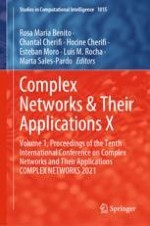2022 | Buch
Complex Networks & Their Applications X
Volume 1, Proceedings of the Tenth International Conference on Complex Networks and Their Applications COMPLEX NETWORKS 2021
herausgegeben von: Rosa Maria Benito, Chantal Cherifi, Hocine Cherifi, Esteban Moro, Luis M. Rocha, Marta Sales-Pardo
Verlag: Springer International Publishing
Buchreihe : Studies in Computational Intelligence
